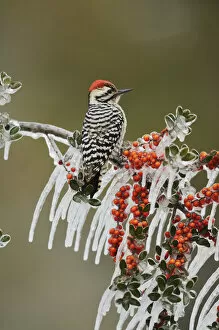Ladder Backed Woodpecker Collection
The Ladder-backed Woodpecker (Picoides scalaris) is a stunning bird species that can be found in various habitats across Texas, USA
For sale as Licensed Images
Choose your image, Select your licence and Download the media
The Ladder-backed Woodpecker (Picoides scalaris) is a stunning bird species that can be found in various habitats across Texas, USA. With its distinct ladder-like pattern on its back, this adult male perched on an icy branch of Possum Haw Holly creates a mesmerizing sight. The juxtaposition of the woodpecker's vibrant plumage against the icy backdrop showcases nature's beauty even in harsh conditions. In another captivating scene, a male Ladder-backed Woodpecker finds solace amidst the blossoming Mexican plum trees. Its red crown and black-and-white striped body stand out against the delicate pink flowers of Prunus mexicana, creating a picturesque moment in Hill Country, Texas. Perched gracefully on an icy branch of Yaupon Holly or feeding amongst blossoming Eastern redbud trees, these woodpeckers demonstrate their adaptability to different environments. Their presence adds vibrancy to any landscape they inhabit. Also known as Dryobates scalaris, these woodpeckers are not just visually striking but also possess impressive skills when it comes to foraging for food and excavating nests. They use their strong bills to drum on tree trunks and search for insects hidden beneath bark or within crevices. The repetitive call of the Ladder-backed Woodpecker echoes through forests and open woodlands alike. These birds play an essential role in maintaining ecosystem balance by controlling insect populations while providing nesting sites for other cavity-nesting species. Whether you spot them during winter with frost-covered branches or witness their interactions with blooming flora during springtime, encountering a Ladder-backed Woodpecker is always a delightful experience. Appreciate their beauty and contribution to our natural world as they continue to thrive in diverse habitats throughout Texas and beyond.





